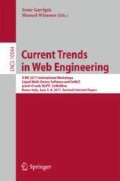Abstract
Internet of Things (IoT) applications and systems pervade our life increasingly and assuring their quality is of paramount importance. Unfortunately, few proposals for testing these complex—and often safety-critical—systems are present in the literature and testers are left alone to build their test cases.
This paper is a first step towards acceptance testing of an IoT system that relies on a smartphone as principal way of interaction between the user and a complex system composed by local sensors/actuators and a remote cloud-based system. A simplified mobile health (m-health) IoT system for diabetic patients is used as an example to explain the proposed approach.
Access this chapter
Tax calculation will be finalised at checkout
Purchases are for personal use only
Notes
- 1.
in [13] this kind of testing is called end-to-end testing.
- 2.
Testware includes artifacts produced during the test process such as, test scripts, inputs, expected results, set-up and clear-up procedures, files, databases, environment, and any additional software or utilities used in testing.
- 3.
- 4.
- 5.
- 6.
- 7.
- 8.
- 9.
- 10.
- 11.
- 12.
- 13.
i.e., that it behaves as specified by the requirements in response to the currently observed glucose pattern. For instance, an alarm is displayed when a problematic pattern is detected (see Test case TC1).
- 14.
the log files plotted in Fig. 3 contain fictitious but realistic glucose level readings recorded every 10 min, thus using the mock of the glucose sensor at 1 read/sec allows to speed up the execution of the test of 600x.
- 15.
since the mock of the glucose sensor provides a new value every second, and all of them are above the 160 mg/dl threshold, after 20 s the system can, in theory, raise the alarm. However, some computations are required on the cloud system. For this reason, system requirements state that the alarm must be shown on the smartphone within 40 s the occurrence of a problematic pattern, thus the test verifies the presence of the alarm after 20 s + 40 s from the first read.
- 16.
References
The top 10 causes of death. World Health Organization (WHO), Geneva, Switzerland (2013). http://www.who.int/mediacentre/factsheets/fs310
Global Report on Diabetes, 1st edn. World Health Organization (WHO), Geneva (2016). http://www.who.int/diabetes/global-report/en/
Chen, T.Y., Ho, J.W., Liu, H., Xie, X.: An innovative approach for testing bioinformatics programs using metamorphic testing. BMC Bioinform. 10(1), 24 (2009)
Clarke, E., Grumberg, O., Peled, D. (eds.): Model Checking, pp. 67–114. MIT Press, Cambridge (1997). https://doi.org/10.1007/978-3-319-10575-8
Clerissi, D., Leotta, M., Reggio, G., Ricca, F.: Test driven development of web applications: a lightweight approach. In: Proceedings of 10th International Conference on the Quality of Information and Communications Technology, QUATIC 2016, pp. 25–34. IEEE (2016)
Istepanian, R., Hu, S., Philip, N., Sungoor, A.: The potential of internet of m-health things "m-IoT" for non-invasive glucose level sensing. In: 33rd International Conference of the IEEE Engineering in Medicine and Biology Society, EMBC 2011, pp. 5264–5266 (2011)
Klonoff, D.C.: The current status of mHealth for diabetes: will it be the next big thing? J. Diab. Sci. Technol. (JDST) 7(3), 749–758 (2013)
Leotta, M., Clerissi, D., Ricca, F., Tonella, P.: Capture-replay vs. programmable web testing: an empirical assessment during test case evolution. In: Proceedings of 20th Working Conference on Reverse Engineering, WCRE 2013, pp. 272–281. IEEE (2013)
Leotta, M., Clerissi, D., Ricca, F., Tonella, P.: Approaches and tools for automated end-to-end web testing. Adv. Comput. 101, 193–237 (2016)
Leotta, M., Stocco, A., Ricca, F., Tonella, P.: ROBULA+: an algorithm for generating robust XPath locators for web testing. J. Softw. Evol. Process 28(3), 177–204 (2016)
Leucker, M., Schallhart, C.: A brief account of runtime verification. J. Logic Algebraic Program. 78(5), 293–303 (2009)
McAdams, B.H., Rizvi, A.A.: An overview of insulin pumps and glucose sensors for the generalist. J. Clin. Med. 5(1) (2016)
Parasoft. End-to-end testing for iot integrity. Technical report. https://alm.parasoft.com/end-to-end-testing-for-iot-integrity
Rosenkranz, P., Wählisch, M., Baccelli, E., Ortmann, L.: A distributed test system architecture for open-source IoT software. In: Proceedings of 1st Workshop on IoT Challenges in Mobile and Industrial Systems, IoT-Sys 2015, pp. 43–48. ACM (2015)
Siboni, S., Shabtai, A., Tippenhauer, N.O., Lee, J., Elovici, Y.: Advanced security testbed framework for wearable IoT devices. ACM Trans. Internet Tech. (TOIT) 16(4), 26 (2016)
Stocco, A., Leotta, M., Ricca, F., Tonella, P.: APOGEN: automatic page object generator for web testing. Softw. Qual. J. 25(3), 1007–1039 (2017). https://doi.org/10.1007/s11219-016-9331-9
Leotta, M., Stocco, A., Ricca, F., Tonella, P.: PESTO: Automated migration of DOM-based web tests towards the visual approach. J. Softw. Test, Verification Reliab. (STVR) (2018, to appear)
Acknowledgements
This research was partially supported by Actelion Pharmaceuticals Italia and SEED 2015 grants.
Author information
Authors and Affiliations
Corresponding author
Editor information
Editors and Affiliations
Rights and permissions
Copyright information
© 2018 Springer International Publishing AG
About this paper
Cite this paper
Leotta, M. et al. (2018). Towards an Acceptance Testing Approach for Internet of Things Systems. In: Garrigós, I., Wimmer, M. (eds) Current Trends in Web Engineering. ICWE 2017. Lecture Notes in Computer Science(), vol 10544. Springer, Cham. https://doi.org/10.1007/978-3-319-74433-9_11
Download citation
DOI: https://doi.org/10.1007/978-3-319-74433-9_11
Published:
Publisher Name: Springer, Cham
Print ISBN: 978-3-319-74432-2
Online ISBN: 978-3-319-74433-9
eBook Packages: Computer ScienceComputer Science (R0)

